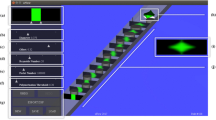Abstract
This paper describes the design of a linear time DNA algorithm for the Hamiltonian Path Problem (HPP) suited for parallel implementation using a microfluidic system. This bioalgorithm was inspired by the algorithm contained in [16] within the tissue P systems model. The algorithm is not based on the usual brute force generate/test technique, but builds the space solution gradually. The possible solutions/paths are built step by step by exploring the graph according to a breadth-first search so that only the paths that represent permutations of the set of vertices, and which, therefore, do not have repeated vertices (a vertex is only added to a path if this vertex is not already present) are extended. This simple distributed DNA algorithm has only two operations: concatenation (append) and sequence separation (filter). The HPP is resolved autonomously by the system, without the need for external control or manipulation. In this paper, we also note other possible bioalgorithms and the relationship of the implicit model used to solve the HPP to other abstract theoretical distributed DNA computing models (test tube distributed systems, grammar systems, parallel automata).
Access this chapter
Tax calculation will be finalised at checkout
Purchases are for personal use only
Preview
Unable to display preview. Download preview PDF.
Similar content being viewed by others
References
Adleman, L.M.: Molecular computation of solutions to combinatorial problems. Science 266, 1021–1024 (1994)
Amos, M., Gibbons, A., Hodgson, D.: Error-resistant implementation of DNA computation. In: Proceedings of the Second Annual Meeting on DNA Based Computers, held at Princeton University, June 10-12 (1996)
Andronescu, M., Dees, D., Slaybaugh, L., Zhao, Y., Condon, A., Cohen, B., Skiena, S.: Algorithms for testing that DNA word designs avoid unwanted secondary structure. In: Hagiya, M., Ohuchi, A. (eds.) DNA 2002. LNCS, vol. 2568, pp. 92–104. Springer, Heidelberg (2003)
Castellanos, J., Martín-Vide, C., Mitrana, V., Sempere, J.: Solving NP-complete problems with networks of evolutionary processors. In: Proc. of the 6th International Work-Conference on Artificial and Natural Neural Networks, IWANN. LNCS, vol. 2048, pp. 621–628 (2001)
Chiu, D.T., Pezzoli, E., Wu, H., Stroock, A.D., Whitesides, G.M.: Using threedimensional microfluidic networks for solving computationally hard problems. PNAS 98(6), 2961–2966 (2001)
Csuhaj-Varju, E., Dassow, J., Kelemen, J., Păun, G.: Grammar Systems. A Grammatical Approach to Distribution and Cooperation. Gordon and Breach, London (1994)
Csuhaj-Varju, E., Kari, L., Păun, G.: Test tube distributed systems based on splicing. Computers and AI 15(2-3), 211–232 (1996)
Csuhaj-Varju, E., Freund, R., Kari, L., Păun, G.: DNA computing based on splicing: universality results. In: Proc. First Annual Pacific Symp. on Biocomputing, Hawaii, pp. 179–190 (1996)
Dassow, J., Martín-Vide, C., Păun, G., Rodríguez-Patón, A.: Conditional concatenation. Fundamenta Informaticae 44(4), 353–372 (2000)
Freund, R., Freund, F.: Test tube systems or how to bake a DNA cake. Acta Cybernetica 12(4), 445–459 (1996)
Gehani, A., Reif, J.H.: Microflow bio-molecular computation. Biosystems 52(1-3), 197–216 (1999)
Gloor, G., Kari, L., Gaasenbeek, M., Yu, S.: Towards a DNA solution to the shortest common superstring problem. In: 4th Int. Meeting on DNA-Based Computing, Baltimore, Penns (June 1998)
Head, T.: Formal language theory and DNA: an analysis of the generative capacity of specific recombinant behaviors. Bull. Math. Biology 49, 737–759 (1987)
Head, T.: Hamiltonian Paths and Double Stranded DNA. In: Păun, G. (ed.) Computing with Bio- Molecules. Theory and Experiments, pp. 80–92. World Scientific, Singapore (1998)
Manz, A., Harrison, D.J., Verpoorte, E.M.J., Fettinger, J.C., Paulus, A., Ludi, H., Widmer, H.M.: Planar chips technology for miniaturization and integration of separation techniques into monitoring systems: “Capillary electrophoresis on a chip. J. Chromatogr. 593, 253–258 (1992)
Martín-Vide, C., Păun, G., Pazos, J., Rodríguez-Patón, A.: Tissue P systems. Theoretical Computer Science 296(2), 295–326 (2003)
McCaskill, J.S.: Optically programming DNA computing in microflow reactors. Biosystems 59(2), 125–138 (2001)
Morimoto, N., Arita, M., Suyama, A.: Solid phase DNA solution to the Hamiltonian path problem. In: Proceedings of the 3rd DIMACS Workshop on DNA Based Computers, The University of Pennsylvania pp. 83–92 (June 1997)
Păun, G., Thierrin, G.: Multiset processing by means of systems of finite state transducers. In: Boldt, O., Jürgensen, H. (eds.) WIA 1999. LNCS, vol. 2214, pp. 140–157. Springer, Heidelberg (2001)
Selvaganapathy, P.R., Carlen, E.T., Mastrangelo, C.H.: Recent Progress in Microfluidic Devices for Nucleic Acid and Antibody Assays. Proceedings of the IEEE 91(6), 954–973 (2003)
Verpoorte, E., De Rooij, N.F.: Microfluidics Meets MEMS. Proceedings of the IEEE 91(6), 930–953 (2003)
Author information
Authors and Affiliations
Editor information
Editors and Affiliations
Rights and permissions
Copyright information
© 2003 Springer-Verlag Berlin Heidelberg
About this chapter
Cite this chapter
Ledesma, L., Pazos, J., Rodríguez-Patón, A. (2003). A DNA Algorithm for the Hamiltonian Path Problem Using Microfluidic Systems. In: Jonoska, N., Păun, G., Rozenberg, G. (eds) Aspects of Molecular Computing. Lecture Notes in Computer Science, vol 2950. Springer, Berlin, Heidelberg. https://doi.org/10.1007/978-3-540-24635-0_21
Download citation
DOI: https://doi.org/10.1007/978-3-540-24635-0_21
Publisher Name: Springer, Berlin, Heidelberg
Print ISBN: 978-3-540-20781-8
Online ISBN: 978-3-540-24635-0
eBook Packages: Springer Book Archive




